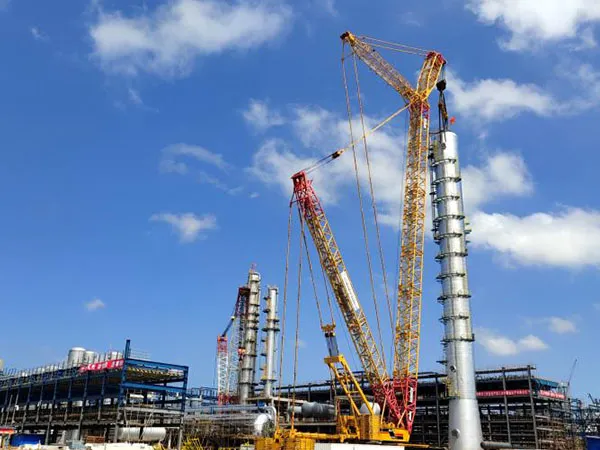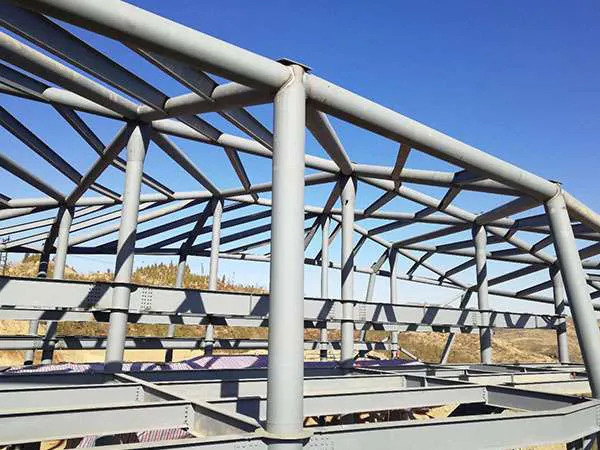Time:2025-09-02 02:43:57 Source:Sanjian Meichen Steel Structure
In modern architecture, steel and concrete are undoubtedly the two most widely used and influential building forms. Each possesses unique engineering aesthetics and functional characteristics, and together they shape the city skylines and infrastructure around us. However, for owners, developers, architects, and the general public, understanding the fundamental differences between the two and making an informed choice based on project requirements is crucial. This article will provide a comprehensive and in-depth comparative analysis of steel and concrete structures from multiple perspectives, including material properties, design flexibility, construction timelines, cost-effectiveness, environmental impact, and future development trends, aiming to provide a clear and comprehensive reference for decision-making.
Steel and concrete are the two most common materials for large-scale construction, but they have key differences in properties, construction methods, cost, and environmental impact. Generally, steel structures are known for their high strength-to-weight ratio, which allows for lighter, more flexible designs and faster construction, while concrete structures are valued for their high compressive strength, durability, and fire resistance.

Steel structures primarily consist of beams, columns, trusses, and other components made of steel sections and steel plates, assembled through welding, bolting, or riveting. Their core advantage lies in steel's inherently superior mechanical properties—high strength, high toughness, and excellent uniformity. This means that, while maintaining the same load-bearing capacity, steel structure components can have smaller cross-sections, enabling larger spans, lighter deadweight, and more flexible interior layouts. From stadiums to super-high-rise buildings, from industrial plants to bridges, steel structures, with their lightweight and efficient construction, exude a unique appeal.
Concrete structures, particularly reinforced concrete, are composite materials composed of cement, sand, gravel, and water mixed in specific proportions, which are then allowed to solidify and harden, with reinforcement embedded within to enhance its tensile properties. Concrete possesses excellent compressive strength and good plasticity, allowing it to conform to a variety of complex geometric shapes before being cast. The combination of reinforced concrete and reinforced concrete perfectly compensates for concrete's lack of tensile strength, making it an ideal choice for a wide range of projects, including residential and commercial buildings and underground structures. Concrete is renowned for its sturdiness, stability, and excellent fire and sound insulation properties.

2.1 Strength and Deadweight
Steel Structures: Steel's tensile, compressive, and shear strengths are significantly higher than those of concrete. Under the same load conditions, steel components can be made smaller, significantly reducing the deadweight of the structure. This is particularly advantageous in areas with poor foundation conditions or for buildings requiring large spans, as it can reduce foundation preparation costs.
Concrete Structures: While concrete has high compressive strength, it is also heavy and has low tensile strength, requiring a large amount of steel reinforcement.
Therefore, for the same load, concrete components typically have larger cross-sections, resulting in a higher overall deadweight.
2.2 Seismic Performance
Steel Structures: Steel exhibits excellent ductility. Under earthquake forces, it absorbs and dissipates seismic energy through plastic deformation, making it less susceptible to brittle failure. Flexible or semi-rigid connections are often used at joints, further enhancing the structure's seismic performance, making it a preferred choice for high-rise buildings in high-intensity earthquake zones.
Concrete Structures: Reinforced concrete structures can also achieve good seismic performance through appropriate reinforcement and structural measures.
However, its ductility is slightly lower than that of steel structures. Under extreme earthquakes, it may crack or even fail, making repair more complex.
2.3 Fire Resistance
Steel Structures: Steel's strength decreases dramatically at high temperatures (e.g., 500-600°C), leading to structural instability. Therefore, steel structures typically require additional protective measures such as fire-retardant coatings, fire-resistant panels, or spraying to meet the required fire protection period.
Concrete Structures: Concrete inherently has excellent fire resistance and low thermal conductivity, effectively protecting internal steel reinforcement from high temperatures. Generally, concrete structures can meet common fire protection requirements without additional fireproofing.
2.4 Corrosion Resistance
Steel Structures: Steel is susceptible to corrosion from environmental factors such as moisture and chemicals, requiring regular anti-corrosion coating and maintenance. In highly corrosive environments, a higher level of corrosion protection is required.
Concrete Structures: Concrete provides excellent protection for internal steel reinforcement, effectively preventing corrosion. However, if concrete cracks or carbonizes, corrosive media can penetrate, potentially causing corrosion.
Ultimately, the choice between steel and concrete depends on various factors, including the building's purpose, span requirements, budget, desired construction speed, location (e.g., seismic zones), and aesthetic considerations. Often, hybrid structures combining both materials are used to leverage the strengths of each.
Steel structures: Components are prefabricated in the factory, requiring only on-site assembly. This significantly reduces on-site wet work, minimizes weather impacts, and offers high precision and rapid construction, making it particularly suitable for projects with tight deadlines.
Concrete structures: Extensive on-site pouring operations require multiple steps, including formwork support, rebar tying, concrete mixing and pouring, and curing. Construction cycles are relatively long and susceptible to weather conditions (such as low temperatures, rain, and snow), with a high volume of wet work.
Steel Structures:
Upfront Costs: Steel itself is relatively expensive, and fireproofing and anti-corrosion treatments add additional costs.
Post-Construction Benefits: Short construction periods save labor costs and financing interest; lightweight components reduce foundation investment; large-span, large-space designs increase usable area and spatial value; the structure is easy to modify, reinforce, and demolish, and residual steel can be recycled, resulting in a high residual value.
Concrete Structures:
Upfront Costs: Materials (cement, sand and gravel) are relatively inexpensive, and initial investment costs are generally lower than those for steel structures.
Post-Construction Benefits: Relatively low maintenance costs, especially for fireproofing and anti-corrosion. However, the long construction period increases time costs; structural modification and demolition are difficult and costly, and the material recycling rate is low.
Steel Structures:
Super-tall and long-span buildings: Such as skyscrapers, stadiums, convention centers, and aircraft hangars, their lightweight and high-strength properties offer significant advantages.
Industrial plants and warehouses: Fast construction, high space utilization, and easy installation of large equipment. Bridges and towers: High strength, light weight, suitable for bearing complex loads.
Multi-story residential and office buildings: Especially suitable for urban projects requiring rapid construction and flexible spatial layouts.
Temporary buildings and movable structures: Easy to disassemble and reuse.
Concrete structures:
Ordinary residential and commercial buildings: Economical, with excellent fire and sound insulation performance, and a wide range of applications.
Underground structures and foundation engineering: Excellent waterproofing, moisture resistance, and impermeability.
Irrigation projects and ports: Excellent water resistance and corrosion resistance.
Applications requiring heavy, stable structures: Such as nuclear power plants and dams.
Buildings requiring high sound and heat insulation requirements.
Steel Structures:
Advantages: Steel is a recyclable, renewable, and green building material with a recycling rate exceeding 90%, in line with the concept of a circular economy.
Factory prefabrication reduces on-site waste.
Disadvantages: Steel production is relatively energy-intensive and generates carbon emissions. Anti-corrosion coatings may contain VOCs (volatile organic compounds).
Concrete Structures:
Advantages: Locally sourced and abundant resources. Long service life and structural stability.
Disadvantages: Cement production is a major source of carbon emissions. The construction process generates a large amount of construction waste, and recycling concrete waste is relatively difficult.
Steel Structures: Due to their high strength and lightweight properties, steel structures offer tremendous design freedom. Architects can create bold and creative structural forms such as large spans, cantilevers, and unusual shapes, achieving transparent, lightweight facades and showcasing a modern industrial aesthetic.
Concrete Structures: Concrete has excellent plasticity and, with the aid of formwork, can be cast into a variety of complex curves and shapes, creating unique architectural forms and surface textures, and exhibiting a calm and profound artistic style.
Steel Structures: Structural renovation and reinforcement are relatively easy, allowing for flexible adjustments through the addition of components and the replacement of connection methods. During demolition, steel components can be recycled and reused, reducing construction waste.
Concrete Structures: Renovation is more difficult, often requiring cutting and chiseling, significantly impacting the original structure. Demolition costs are high, and the resulting volume of construction waste is substantial, much of which is difficult to effectively recycle.
Conclusion: Balanced Considerations Lead to Wise Choices
Steel and concrete structures each have their own advantages. This isn't a simple comparison of superiority or inferiority; rather, it's a comprehensive balance of factors, including specific project requirements, budget, construction schedule, location, environmental conditions, and design philosophy.
When projects require rapid construction, large spans, lightweight and high strength, flexible spaces, and future adaptability, steel structures are often the more ideal choice.
When projects are cost-sensitive, require excellent fire and sound insulation, seek a robust and stable structure, and are less demanding on speed, concrete structures may offer advantages.
In actual projects, steel-concrete composite structures are often employed, such as steel frame-concrete core, or reinforced concrete floor slabs combined with steel beams, to leverage the advantages of both, achieving optimal structural performance and economic benefits.
As a professional provider of building structural solutions, Meichen Steel is committed to providing comprehensive steel structure services, from design and fabrication to installation. We understand the value of each structural form and can tailor the most appropriate solution to your specific needs. Before making a final decision, we strongly recommend consulting with a professional engineering and design team to conduct an in-depth feasibility study and cost-benefit analysis to ensure your building project is both safe, reliable, and cost-effective.